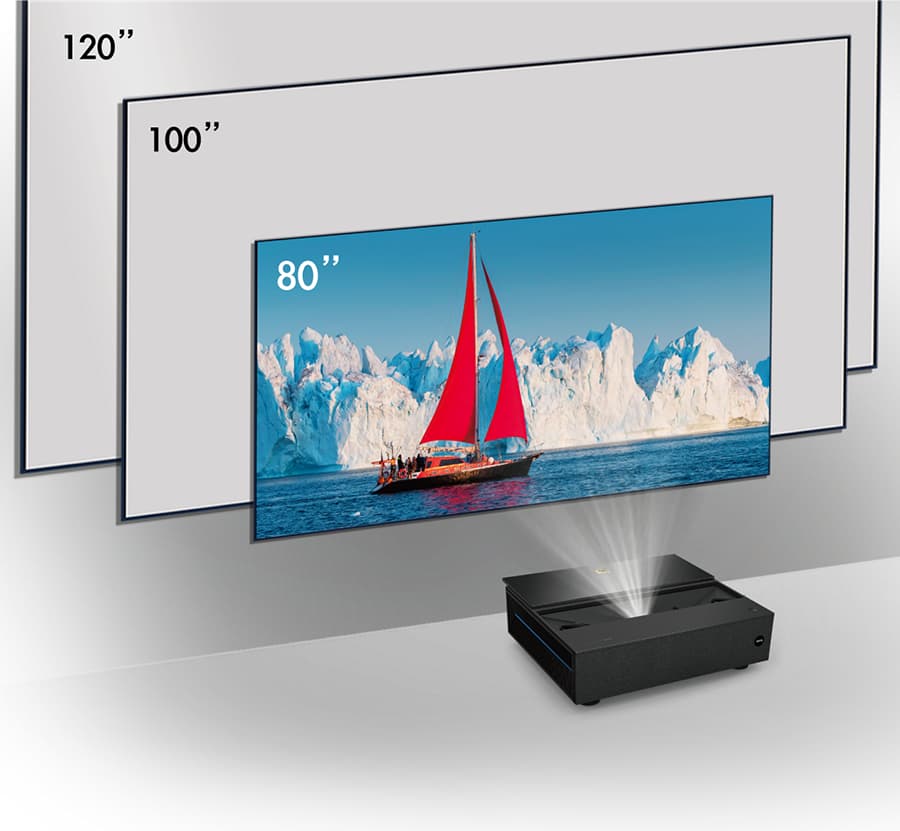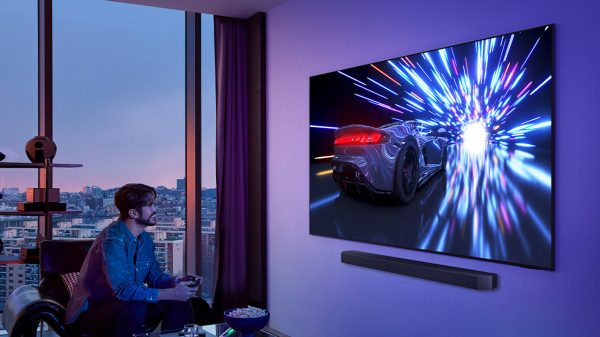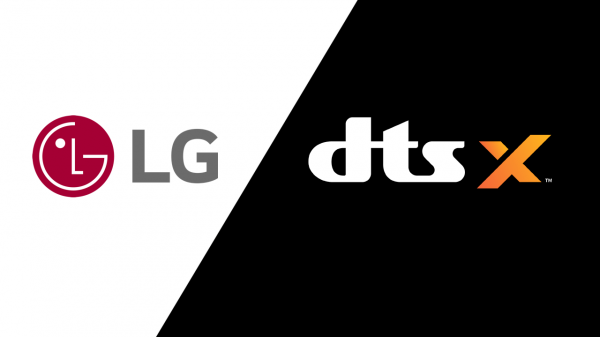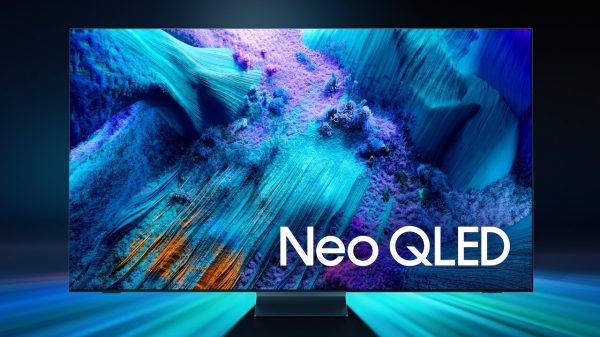TV manufacturers are convinced that consumers are ready to take the large TV plunge in 2024 and whilst some of the models that we examined at CES and CEDIA were extremely impressive, we are not sure that most are people are willing to spend that kind of money at this point. Not every model, however, will destroy your bank account. TCL now has three 98-inch 4K TVs priced from $2,000 to $6,000. However, LG’s top-of-the-line 97-inch M3 OLED TV will still set you back $30K. There is a lot of room in that range and that’s where Ultra Short Throw (UST) projectors come into the picture.
At the 120-inch screen size, there isn’t a more affordable or easier alternative than an Ultra Short Throw (UST) projector with an ALR screen. There are a number of UST/ALR screen combinations that start around $3,000 and we expect to see more of them as more competitors jump into the market and the technology becomes more affordable.
What is an Ultra Short Throw (UST) Projector?
An Ultra Throw Projector (aka UST) has a specially constructed lens assembly that allows images to be displayed from a very short distance, generally less than a foot away from the screen. This means instead of placing the projector far way behind the seating position, it sits close up below a screen without sacrificing image size. UST projectors can project very large images without taking much more space than a large TV. They are also great for those that have small rooms.

The key advantage of a UST projector with a screen is the substantial cost savings when compared to purchasing a flat panel TV sized above 85 inches. The next big advantage is the elimination of glare that plagues every glass panel. With the appropriate screen, a UST projector can create enjoyable big screen images, even in relatively bright rooms.
Tip: Most 2024 UST projectors offer 4K or 4K-like resolution via a process called Pixel Shifting. There are no 8K models yet for sale, although some have been announced. Some 1080p UST projectors are also available at more budget-friendly pricing.
Of course, there are some drawbacks to 4K UST projectors. Like any projector, or really any display of any kind, their main enemy is light in the room. Specialized ambient light-reflecting (ALR) screens can mitigate the problem, but as with any projector, they still look best in a darkened room.

Having reviewed The Premiere by Samsung LSP9T 4K UST Projector, we can attest that watching movies on a 103-inch screen is even more enjoyable than a near pixel-perfect 65-inch Sony OLED 4K TV. Bigger is just better.
Tip: UST Projectors are sometimes referred to as Laser TVs (such as Hisense models). This is because they use lasers in place of standard projection bulbs and their built-in speakers and simplified installation makes them a viable replacement to a flat panel TV.
Although the Samsung LSP9T is one of the best, it’s also the most expensive, which opens the door to a lot of competition.
One very affordable competitor that was chosen as the best Triple Laser UST at the 2023 Laser TV Showdown held by Projector Central and ProjectionScreen.com was the Formovie Theater T1 which has a surprisingly low $2,999 price tag.

The Samsung LSP9T and Formovie T1 are just two possible choices as there are now well over two dozen models to choose from, which can be quite overwhelming.
4K UST Projector Comparison Chart
Since we have reported on many USTs, we thought it would be great to provide a guide that lists the brands and models, some of the key features, plus a link back to our more detailed articles on each brand and model reported.
Click the brand/model of each projector for more details in our original article or click the price to check current pricing and availability.
Comparison
| Projector | MSRP | Light Engine | Lumens (ANSI) | Sound | OS | Size |
| AWOL LTV-2500 | $2,999 | Triple Laser | 2,600 | 2 x 18 watts | Android | 80-150″ |
| AWOL LTV-3000 PRO | $3,999 | Triple Laser | 3,000 | 2 x 18 watts | Android | 80-150″ |
| AWOL LTV-3500 PRO | $5,999 | Triple Laser | 3,500 | 2 x 18 watts | Android | 80-150″ |
| BENQ V5000i | $3,499 | Triple Laser | 2,800 | 2 x 5 watts plus 2 x 15 watts subwoofer | N/A | 70-100″ |
| BenQ V7050i | $3,999 | Laser / Phosphor | 2,500 | 2 x 5 watts | Android | 90-100″ |
| Epson LS500 | $3,199 | Laser 3LCD | 4,000 | 2x 10 watts | Android | 70-130″ |
| Epson LS650 | $2,700 | Single Laser | 3,600 | 2 x 5 watts full range and 1x 10 watts subwoofer | Android TV | 60-120″ |
| Epson LS800 | $3,499 | Laser 3LCD | 4,000 | 20 watts total | Android | 80-150” |
| Formovie C3 | $1,899 | Single Laser | 2,250 | 2 x 15 watts | FengOS 3.0 | 80-120″ |
| Formovie Theater T1 | $2,999 | Triple Laser | 2,800 | 2 x 15 watts | Android | 80-150” |
| Formovie 4K Max | $3,699 | Triple Laser | 4,500 | N/A | Feng OS 1.2 | 100-200″ |
| Hisense L5H | $2,999* | Laser / Phosphor | 2,700 | 40 watts total | Android | 100/120″ |
| Hisense L9H | $4,999* | TriChroma Laser | 3,000 | 40 watts total | Android | 100/120″ |
| Hisense PL1 | $2,499 | Single Laser | 2,100 | 2 x 15 watts | Google TV | 80-120″ |
| Hisense PX1 | $2,498 | TriChroma Laser | 2,000 | 30 watts total | Android | 100 – 120” |
| Hisense PX1-Pro | $2,999 | TriChroma Laser | 2,200 | 30 watts total | Android | 90-130″ |
| Hisense PX2-Pro | $2,999 | TriChroma Laser | 2,400 | 2 x 15 watts | Google TV | 90-130″ |
| JMGO U2 | $2,999 | Triple Laser | 2,400 | 50 watts total | Luna OS | 100″ |
| Leica Cine 1 | $9,495 | TriChroma Laser | 3,000 | 2 x 25 watts | Google TV | 100 or 120” |
| LG HU715QW | $2,499 | Laser / Phosphor | 2,500 | 20 watts x 2 | WebOS | 80-120″ |
| LG HU915QB | $6,496 | 3-Channel Laser | 3,000 | 2.2 channels, 40 watts total | WebOS | 90-100″ |
| LG HU915QE | $5,996 | 3-Channel Laser | 3,700 | 2.2 channels, 40 watts total | WebOS | 90-120″ |
| Nexigo Aurora Pro | $2,999 | Triple Laser | 2,400 | 2 x 15W Woofers, 2 x 15W Tweeters | Android | 80-150″ |
| Optoma Cinema X D2 | $2,499 | Dual Core Laser | 3,000 | 2 x 10 watts | None | 85 -120” |
| Optoma Cinema X D2 Smart | $2,699 | Dual Core Laser | 3,000 | 2 x 10 watts | Android (w/dongle) | 85 -120” |
| Optoma CinemaX P2 | $3,299 | Single Laser w/ 6-SegmentColor Wheel | 3,000 | 40 watts total | Android | 85-120″ |
| Samsung LSP7T | $2,999 | Single Laser | 2,200 | 2.2 Channels, 30 watts total | Tizen | 90-120″ |
| Samsung LSP9T | $6,499 | Triple Laser | 2,800 | 4.2 Channels, 40 watts total | Tizen | 100-130” |
| Ultimea Thor T50 | $3,999 | Laser Phosphor | 3,000 | 2 x10 watts | Android TV 11.0 | 80-150″ |
| Ultimea Thor T60 | $4,999 | Triple Laser | 4,999 | 2 x 15 watts | Android | 80-200″ |
| Vava Chroma | $3,599 | Laser / Phosphor | 1,800 | 2 x 30 watts | Android | 80-150″ |
| Viewsonic X2000B-4K | $2,399 | Laser / Phosphor | 2,000 | 2 x 25 watts | Android | 65-150″ |
| XGIMI Aura | $2,349 | Laser / Phosphor | 2,400 | 4 x 15 watts | Android | 80-120″ |
*Includes screen.
Note: As new projector models are released, we’ll attempt to keep this list up-to-date, while also removing models that become discontinued. Pricing noted as of February 2024, but may vary due to promotion or market conditions.
Where to buy: Value Electronics | Projector Screen | Amazon
Related reading:










































Phil Davis
November 11, 2023 at 2:21 pm
I bought an Epson laser projector
directly from Epson for under $800.
Works fine….any of these pricy front
projectors will get U a better view
of every flaw on a woman’s face….etc
I don’t need that.
Neil
June 5, 2024 at 5:38 pm
Should Wemax not be listed as well?